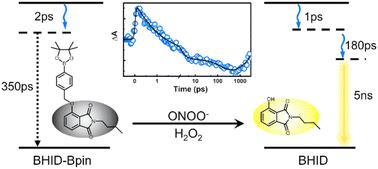当前位置:
X-MOL 学术
›
Phys. Chem. Chem. Phys.
›
论文详情
Our official English website, www.x-mol.net, welcomes your
feedback! (Note: you will need to create a separate account there.)
Excited-state dynamics of 4-hydroxyisoindoline-1,3-dione and its derivative as fluorescent probes
Physical Chemistry Chemical Physics ( IF 2.9 ) Pub Date : 2024-04-03 , DOI: 10.1039/d3cp05777a Li Zhao 1 , Simin Jiang 2 , Yanmei He 2, 3 , Luling Wu 4 , Tony D James 4, 5 , Junsheng Chen 2
Physical Chemistry Chemical Physics ( IF 2.9 ) Pub Date : 2024-04-03 , DOI: 10.1039/d3cp05777a Li Zhao 1 , Simin Jiang 2 , Yanmei He 2, 3 , Luling Wu 4 , Tony D James 4, 5 , Junsheng Chen 2
Affiliation

|
Fluorescent probes have become promising tools for monitoring the concentration of peroxynitrite, which is linked to many diseases. However, despite focusing on developing numerous peroxynitrite based fluorescent probes, limited emphasis is placed on their sensing mechanism. Here, we investigated the sensing mechanism of a peroxynitrite fluorescent probe, named BHID-Bpin, with a focus on the relevant excited state dynamics. The photoexcited BHID-Bpin relaxes to its ground state via an efficient nonradiative process (∼300 ps) due to the presence of a minimum energy conical intersection between its first excited state and ground state. However, upon reacting with peroxynitrite, the Bpin moiety is cleaved from BHID-Bpin and BHID is formed. The formed BHID exhibits strong dual band fluorescence which is caused by an ultrafast excited-state intramolecular proton transfer process (∼1 ps).
中文翻译:

4-羟基异吲哚啉-1,3-二酮及其衍生物作为荧光探针的激发态动力学
荧光探针已成为监测过氧亚硝酸盐浓度的有前途的工具,过氧亚硝酸盐与许多疾病有关。然而,尽管专注于开发大量基于过亚硝酸盐的荧光探针,但对其传感机制的重视有限。在这里,我们研究了名为BHID-Bpin的过氧亚硝酸盐荧光探针的传感机制,重点关注相关的激发态动力学。由于其第一激发态和基态之间存在最小能量圆锥相交,光激发BHID-Bpin通过有效的非辐射过程(~300 ps)松弛到其基态。然而,在与过氧亚硝酸盐反应时,Bpin 部分从BHID-Bpin上裂解并形成BHID 。形成的BHID表现出强烈的双带荧光,这是由超快激发态分子内质子转移过程(~1 ps)引起的。
更新日期:2024-04-03
中文翻译:

4-羟基异吲哚啉-1,3-二酮及其衍生物作为荧光探针的激发态动力学
荧光探针已成为监测过氧亚硝酸盐浓度的有前途的工具,过氧亚硝酸盐与许多疾病有关。然而,尽管专注于开发大量基于过亚硝酸盐的荧光探针,但对其传感机制的重视有限。在这里,我们研究了名为BHID-Bpin的过氧亚硝酸盐荧光探针的传感机制,重点关注相关的激发态动力学。由于其第一激发态和基态之间存在最小能量圆锥相交,光激发BHID-Bpin通过有效的非辐射过程(~300 ps)松弛到其基态。然而,在与过氧亚硝酸盐反应时,Bpin 部分从BHID-Bpin上裂解并形成BHID 。形成的BHID表现出强烈的双带荧光,这是由超快激发态分子内质子转移过程(~1 ps)引起的。































 京公网安备 11010802027423号
京公网安备 11010802027423号